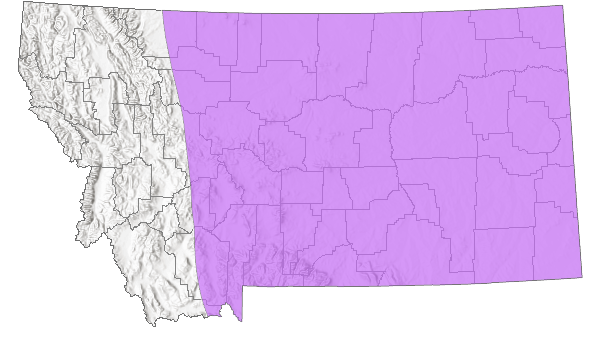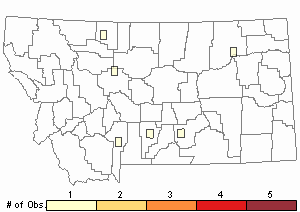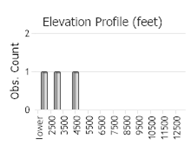View in other NatureServe Network Field Guides
NatureServe
Montana
Utah
Wyoming
Idaho
Wisconsin
British Columbia
South Carolina
Yukon
California
New York
Prairie Meadow Katydid - Conocephalus saltans
General Description
The following is taken from Rehn and Hebard (1914), Blatchley (1920), Vickery and Kevan (1985), and Bland (2003). The body is very small and slender, the general color can vary from a dull brown to green. A dark brown stripe, bordered by white, traverses the entire dorsal surface. The front wings (tegmina) are short and cover only about one-fourth of the abdomen, with the tips rounded. This is a flightless katydid species and the only species in the Conocephalus genus to possess two, rather than three, stout spurs on the tip of the hind tibia. The female ovipositor is dark brown, and is as long as or longer than the body and is feebly curved. This species is less active than other katydids, jumping shorter distances when disturbed, and staying close to the ground rather than clinging to the stems of grasses in its habitat.
Calling song description
Bland (2003) describes this species calling song as “males produce an irregular series of soft, individual ticks along with rapidly delivered ticks forming a buzz lasting up to 5 seconds.” Very little information is available relative to this species’ stridulation.
Phenology
The Prairie Meadow Katydid overwinters in the egg stage. Adults present from late July to mid-September or early October, depending upon killing frost occurrence (Vickery and Kevan 1985, and Bland 2003).
Diagnostic Characteristics
The following comes from Rehn and Hebard (1915), Blatchley (1920), Vickery and Kevan (1985), and Bland (2003). The male body length is 11-14 mm, and females 12.8-15.5 mm. The pronotum for male and female is 3-3.5 mm and the tegmina (forewing) for males is 3-3.5 mm, and females 2.5-2.7 mm. The hind femur on the male and female is 11-12 mm and the female ovipositor is 13.5-15 mm. Refer to the illustration for the
Slender Meadow Katydid (
C. fasciatus) to compare the male cerci shape and female ovipositor length. The male cercus apical part is distinctly twisted and incurved.
The Prairie Meadow Katydid can be confused with the
Straight-lanced Meadow Katydid (
Conocephalus strictus), as both species have wings shorter than their abdomens. Refer to the illustration for the
Slender Meadow Katydid (
C. fasciatus), to compare the male cerci shape and female ovipositor length (Scott personal journal note 2021).
Species Range
Montana Range
Range Descriptions

 Native
Native
Range Comments
This species occurs across the U.S. from the east coast to the eastern two-thirds of Montana and southern half of Alberta. South to the Gulf Coast of east Texas to northern Florida. In Montana, this species has been reported in 10 counties (Vickery and Kevan 1985, and Walker SINA website 2020).
Observations in Montana Natural Heritage Program Database
Number of Observations: 11
(Click on the following maps and charts to see full sized version)
Map Help and Descriptions
Relative Density

Recency



 (Observations spanning multiple months or years are excluded from time charts)
(Observations spanning multiple months or years are excluded from time charts)
Habitat
Frequents areas with mixed grasses and forbs in dry upland fields, prairies, dry pastures and sand barrens, and can also be found in marshy areas (Vickery and Kevan 1985, and Bland 2003).
Food Habits
Among the limited references cited below, no specific information relative to food habits for this species can be found. However, in view of its habitat, the Prairie Meadow Katydid likely has a similar diet to that of the
Slender Meadow Katydid (
C. fasciatus), including a mixed diet of grass flowers, seeds and possibly insects.
Reproductive Characteristics
To date, no detailed studies nor observations specific to this species have been found within the published literature.
Stewardship Responsibility
References
- Literature Cited AboveLegend:
 View Online Publication
View Online Publication Bland, R.G. 2003. The Orthoptera of Michigan—Biology, Keys, and Descriptions of Grasshoppers, Katydids, and Crickets. East Lansing, MI: Michigan State University Extension, Bulletin E-2815. 221 p.
Bland, R.G. 2003. The Orthoptera of Michigan—Biology, Keys, and Descriptions of Grasshoppers, Katydids, and Crickets. East Lansing, MI: Michigan State University Extension, Bulletin E-2815. 221 p. Blatchley, W. 1920. Orthoptera of Northeastern America, section Phaneropterinae pp. 459-494. In: Nature Publishing, Indianapolis, IN.
Blatchley, W. 1920. Orthoptera of Northeastern America, section Phaneropterinae pp. 459-494. In: Nature Publishing, Indianapolis, IN. Rehn, J.A. and M. Hebard. 1914. Studies in American Tettigoniidae. Transactions of the American Entomological Society x1:271-344.
Rehn, J.A. and M. Hebard. 1914. Studies in American Tettigoniidae. Transactions of the American Entomological Society x1:271-344. Scott, R. 2021. Personal journal note.
Scott, R. 2021. Personal journal note. Vickery, V. R. and D. K. M. Kevan. 1985. The grasshopper, crickets, and related insects of Canada and adjacent regions. Biosystematics Research Institute, Ottawa, Ontario. Publication Number 1777. 918 pp.
Vickery, V. R. and D. K. M. Kevan. 1985. The grasshopper, crickets, and related insects of Canada and adjacent regions. Biosystematics Research Institute, Ottawa, Ontario. Publication Number 1777. 918 pp. Walker T.J.(ed.). 2020. Singing insects of North America. Accessed 10 February 2021. https://orthsoc.org/sina/
Walker T.J.(ed.). 2020. Singing insects of North America. Accessed 10 February 2021. https://orthsoc.org/sina/
- Additional ReferencesLegend:
 View Online Publication
View Online Publication
Do you know of a citation we're missing? Capinera, J.L., R.D. Scott, and T.J. Walker. 2004. Field Guide to Grasshoppers, Katydids, and Crickets of the United States. Ithaca, NY. Cornell University Press.
Capinera, J.L., R.D. Scott, and T.J. Walker. 2004. Field Guide to Grasshoppers, Katydids, and Crickets of the United States. Ithaca, NY. Cornell University Press. Fulton, B.B. 1933. Stridulating organs of female Tettigoniidae (Orthoptera). Entomological News XLIV:270-275.
Fulton, B.B. 1933. Stridulating organs of female Tettigoniidae (Orthoptera). Entomological News XLIV:270-275. Gwynne, D.T. 2001. Katydids and Bush-Crickets, Reproductive Behavior and Evolution of the Tettigoniidae. Ithaca, NY: Cornell University Press.
Gwynne, D.T. 2001. Katydids and Bush-Crickets, Reproductive Behavior and Evolution of the Tettigoniidae. Ithaca, NY: Cornell University Press. Hebard, M. 1928. The Orthoptera of Montana. Proceedings of the Academy of Natural Sciences of Philadelphia, Vol. 80:211-306.
Hebard, M. 1928. The Orthoptera of Montana. Proceedings of the Academy of Natural Sciences of Philadelphia, Vol. 80:211-306. Scott, R.D. 2010. Montana Grasshoppers, Katydids, and Crickets A Pictorial Field Guide to the Orthoptera. MagpieMTGraphics, Billings, MT.
Scott, R.D. 2010. Montana Grasshoppers, Katydids, and Crickets A Pictorial Field Guide to the Orthoptera. MagpieMTGraphics, Billings, MT.
- Web Search Engines for Articles on "Prairie Meadow Katydid"
- Additional Sources of Information Related to "Insects"





